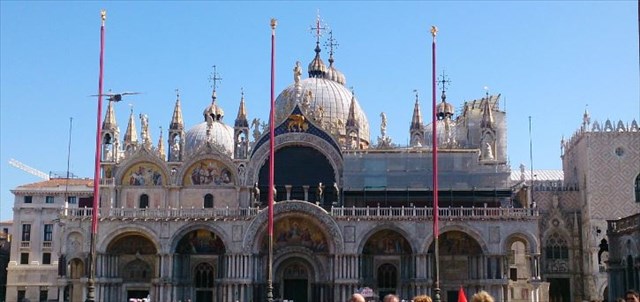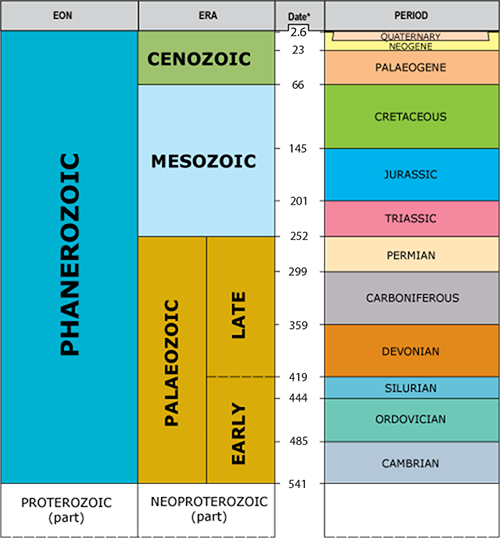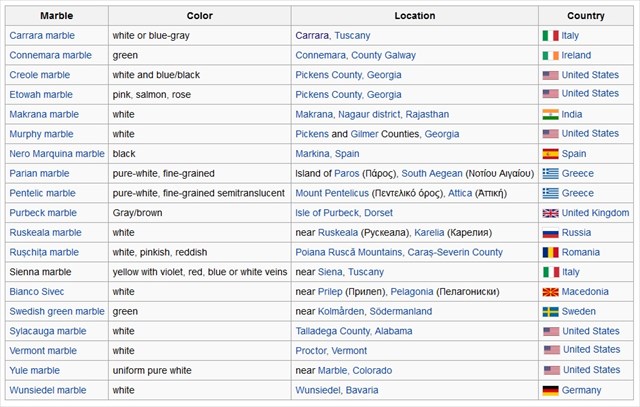Marmo a Basilica Cattedrale Patriarcale di San Marco

Lets learn more about the Metamorphic Rocks and the Marble Stone:
Metamorphic Rocks
These rocks get their name from the Greek words ‘meta’ and ‘morph’, meaning ‘change of form’. Metamorphic rocks are produced by the alteration of pre-formed rocks by pressure, temperature and migrating fluids, often in environments deep in the Earth’s crust. Because of the severe conditions which rocks undergo during metamorphism, the original minerals may become unstable and change to maintain equilibrium with the new environment. This can involve changes in mineralogy (recrystallization of existing minerals or formation of new ones) and usually changes in texture from the original rock.
Three main types of metamorphism are recognized. Regional metamorphism results from mountain-building events with large scale folding and burial of pre-formed rocks. Contact metamorphism is produced by direct heating of rocks around an igneous intrusion, baking the surrounding country rocks. Dynamic metamorphism occurs where large scale faulting breaks and deforms rocks next to the fault.

What is Marble?
Marble is a metamorphic rock formed when limestone is exposed to high temperatures and pressures. Marble forms under such conditions because the calcite forming the limestone recrystallises forming a denser rock consisting of roughly equigranular calcite crystals. The variety of colors exhibited by marble are a consequence of minor amounts of impurities being incorporated with the calcite during metamorphism. This may lead to the formation of new minerals in the stone.
While marble can appear superficially similar to quartzite, a piece of marble will be able to be scratched by a metal blade, and marble will fizz on contact with dilute hydrochloric acid.
How Does Marble Form?
Most marble forms at convergent plate boundaries where large areas of Earth's crust are exposed to regional metamorphism. Some marble also forms by contact metamorphism when a hot magma body heats adjacent limestone or dolostone.
Before metamorphism, the calcite in the limestone is often in the form of lithified fossil material and biological debris. During metamorphism, this calcite recrystallizes and the texture of the rock changes. In the early stages of the limestone-to-marble transformation, the calcite crystals in the rock are very small. In a freshly-broken hand specimen, they might only be recognized as a sugary sparkle of light reflecting from their tiny cleavage faces when the rock is played in the light.
As metamorphism progresses, the crystals grow larger and become easily recognizable as interlocking crystals of calcite. Recrystallization obscures the original fossils and sedimentary structures of the limestone. It also occurs without forming foliation, which normally is found in rocks that are altered by the directed pressure of a convergent plate boundary. Limestone was made during the period of the Jurassic part, while Marble is older and found deeper down in the crust.
Recrystallization is what marks the separation between limestone and marble. Marble that has been exposed to low levels of metamorphism will have very small calcite crystals. The crystals become larger as the level of metamorphism progresses. Clay minerals within the marble will alter to micas and more complex silicate structures as the level of metamorphism increases.

Marble Properties
Color:Marble is usually a light-colored rock. When it is formed from a limestone with very few impurities, it will be white in color. Marble that contains impurities such as clay minerals, iron oxides, or bituminous material can be bluish, gray, pink, yellow, or black in color.
Marble of extremely high purity with a bright white color is very useful. It is often mined, crushed to a powder, and then processed to remove as many impurities as possible. The resulting product is called "whiting." This powder is used as a coloring agent and filler in paint, whitewash, putty, plastic, grout, cosmetics, paper, and other manufactured products.

List of types of marble. Examples of historically notable marble varieties and locations
Hardness: Being composed of calcite, marble has a hardness of three on the Mohs hardness scale. As a result, marble is easy to carve, and that makes it useful for producing sculptures and ornamental objects. The translucence of marble makes it especially attractive for many types of sculptures.
Mineralogy: 95% calcite (CaCO3) or dolomite Ca,Mg(CO3)2. Impurities may give rise to new minerals such as olivine.
Composition: calcareous.
Texture: medium to coarse grained, often showing a sugary texture.

Examples of famous marble used:
The worlds famous white marble comes from Carrara in the Italian Appenines where it has been quarried for two thousand years. It is probably the finest in the world for sculpture, and has been used by famous sculptors such as Donatello, Michelangelo and Canova for their masterpieces. The Taj Mahal in India is built of white marble from Makrana.
To log this cache.
To get to log this cache you will have to visit and answer the questions which are related to the coordinates given to the earthcache.
When answers are collected, send them to CO for verification.
You can log immediately answers are sent CO. If there are any questions about your answers CO will contact you.
Logs without answers to CO or with pending questions from CO will be deleted without any further notice.
Please do not include pictures in your log that may answer the questions.
Questions
1. Answer the questions under by visiting the Coordinates.
A. You now stand in front of the main door, have a look at the columns both left and right and describe the Marble you see at gz, ? And as Marble is formed from limestone, you often find fossils in limestone. Can any fossils be seen here? If so, what types of fossils? (crinoids/corals/brachiopods)
B. Why are some of the stone columns light/medium, and others dark colored?
C. - From what you see at gz, what are the three typical colors that you find used for the Marble of the columns?
- And what is it that the impurities in the marble stone may give rise to?
- Study the columns and by using the diagram above in the text: List of types of marble. Examples of historically notable marble varieties and locations. Could you mention the two different types out from what you see at the location that has definitely been used as a columns here! And why is that?
D. What period of time does the displayed Marble come from? (Use the diagram above from the cache text, and pick your answer from the right hand side, saying: Period.)
2. Take a photo of yourself, the group or your GPS when logging the cache.
Without revealing any answers!
(It’s voluntary to post a photo in your online log)

Storia: Basilica di San Marco, Pietra e marmo
Dopo la conquista di Costantinopoli nel 1204, Venezia ha l’opportunità di disporre di una grande quantità di marmi preziosi appartenenti ad edifici sacri e profani della capitale dell’impero romano d’oriente. A San Marco giungono moltissimi manufatti in marmo che vanno a decorare le facciate e l’interno della basilica.
I marmi più vari vengono utilizzati in funzione simbolica, a seconda delle loro caratteristiche e del loro colore.

Gli elementi marmorei sono un aspetto estremamente interessante nell’ambito della decorazione della basilica sia che riguardino i rivestimenti che gli arredi liturgici. La maggior parte di questi pezzi è materiale di reimpiego e proviene per lo più da edifici di Costantinopoli o da regioni ad essa collegate. L’importazione a Venezia di questi manufatti è documentata a partire dal lX secolo, ma è in seguito alle vicende della Crociata del 1204 che l’afflusso dei marmi si fa più massiccio.
Nel programma della decorazione di San Marco viene seguito il criterio tardoantico, che tiene conto, per i materiali marmorei, anche delle loro caratteristiche di colore e composizione, utilizzati in funzione simbolica. I marmi sono usati per sottolineare determinate funzioni o l’importanza di certi spazi, seguendo una prassi che dalla tarda antichità sopravvive nella tradizione simbolico-decorativa dell’lmpero bizantino e in parte anche nel Medioevo occidentale.
La pietra più preziosa è il porfido rosso, legato alla simbologia imperiale dall’età tardoantica, associato alla porpora, sostanza e colore simbolo di regalità e divinità. Di questo marmo sono composti, tra gli altri, il gruppo dei Tetrarchi (facciata sud) e la tribuna del doge (interno). All’epoca in cui i Veneziani costruiscono San Marco, la porpora, e di conseguenza il porfido, sono legati a una forte simbologia imperiale e divina propria dell’Impero bizantino: trovarsi di fronte a un manufatto di porfido significa avere un oggetto legato a una committenza imperiale. In San Marco l’uso del porfido è legato a quelle sistemazioni che servono a sottolineare la grandezza politica e la gloria di Venezia, senza alcuna implicazione religiosa: il gruppo dei Tetrarchi nell’angolo del Tesoro a evidenziare l’ingresso verso il palazzo ducale, le colonne poste come decorazione della porta centrale della facciata ovest della basilica quasi come un arco trionfale, o agli angoli della facciata stessa, come a delimitare uno spazio regale.

All’interno della basilica gli unici elementi in porfido si trovano nel cosiddetto “ambone” meridionale, in origine la tribuna del doge, altro simbolo di potere. A volte, in mancanza di porfido, è stato utilizzato il marmo iassense, di colore rosso scuro venato di bianco, in particolar modo per i rivestimenti parietali, solo con intenti decorativi. Un altro marmo prezioso con macchie violacee o rossastre, il marmo docimio o pavonazzetto è presente sempre in posizione privilegiata, come le colonne poste nell’ abside.
Secondo la gerarchia dei marmi imperiali, dopo il porfido seguono i marmi verdi (come il serpentino, usato in San Marco per piccoli oggetti o il verde di Tessaglia), poi il bianco e nero di Aquitania. Il verde di Tessaglia e bianco-nero di Aquitania sono usati in ambito imperiale per sarcofagi e lastre di rivestimento. In San Marco la breccia di Aquitania è presente sotto forma di fusti di colonna, a decorare le porte del nartece o il portale principale della facciata ovest o quello della facciata meridionale; la breccia verde di Tessaglia, più diffusa, è usata, oltre che per fusti di colonna, anche per lastre di rivestimento, elementi di arredo liturgico, come l’ambone settentrionale, utilizzato per le letture liturgiche, e il ciborio dell’ altare; è poi presente una mensa d’altare in verde di Tessaglia come rivestimento parietale della facciata settentrionale e una lastra, forse di sarcofago, sempre nello stesso marmo, e inserita nel muro del Tesoro.
Infine i marmi venati vengono usati in funzione decorativa sfruttando la disposizione delle venature stesse: ad esempio le colonne in proconnesio, marmo bianco con venature grigiastre, sono disposte in modo da rispettare corrispondenza e simmetria in base alla disposizione orizzontale delle venature. Per quanto riguarda i rivestimenti parietali, le lastre sono tagliate in modo tale che le venature formino decorazioni geometriche. Esempi chiari si notano nel rivestimento interno dove le venature delle lastre formano ampie fasce a “zig-zag” o losanghe disposte in senso verticale od orizzontale.

History: Basilica di San Marco, Stone and Marble
After the conquest of Constantinople in 1204, Venice had access to a great quantity of precious marbles from the sacred and civic buildings of the capital of the Eastern Roman Empire. A great many marble articles were sent to St. Mark’s and used to decorate the facades and interior.
The most varied marbles were used with a symbolic function depending on their characteristics and color. The most precious stone is red porphyry, symbol of imperial and divine power. Among other things this marble was used for the Tetrarchs group (south facade) and the doge’s tribune (interior).

The marble elements decorating the basilica are of extreme interest from the viewpoint of both the coverings and the liturgical furnishings. Most of these are reused materials taken chiefly from buildings in Constantinople or associated regions. Importation to Venice of these items was documented as early as the 9th century, but it was after the venture of the Crusade of 1204 that the flow of marbles became more intense.
The late-antique criterion was followed in decorating St. Mark’s. As regards marbles this also took into account their features of color and composition which were used with a symbolic function. Marbles were employed to underline determined functions or the importance of certain spaces in accordance with a practice which from late antiquity was to survive in the symbolic-decorative tradition of the Byzantine empire and also, in part, in the Middle Ages in the west.
The most precious stone was red porphyry, linked to the imperial symbology of the late-antique period and associated with purple, a substance and color that symbolised royalty and divinity. In the period when the Venetians built St. Mark’s, purple, and consequently porphyry, were linked to a powerful imperial and divine symbology proper to the Byzantine empire: an object made of porphyry was something connected with an imperial purchaser. In St. Mark’s the use of porphyry is associated with solutions whose purpose was to underline Venice’s political greatness and glory, without any religious implications: such as the group of the Tetrarchs in the corner of the Treasury, highlighting the entrance towards the ducal palace; the columns decorating the central door of the basilica’s west facade, almost like a triumphal arch, or at the corners of the facade as if delimiting a royal space. The only porphyry elements in the interior are in the so-named southern “ambo”, originally the doge’s tribune, another symbol of power. Sometimes when porphyry was not available, Iassense marble was used. Dark red with white veins it was especially employed in wall coverings but with a solely decorative intention. Another precious marble with violet or reddish markings – Docimeum or pavonazzetto marble – is always used in a privileged position, such as the apse columns.

After porphyry in the hierarchy of imperial marbles come the green marbles (e.g. serpentine, used in St. Mark’s for small objects, or Thessaly green) followed by Aquitaine white and black. Thessaly green and Aquitaine white-black are used in an imperial context for sarcophagi and covering slabs. Aquitaine breccia is present in St. Mark’s in the form of column shafts decorating the narthex doors and the main portals of the west and south facade. Green Thessaly breccia, much more in evidence, is used not only for column shafts but also for covering slabs, elements of liturgical furnishings such as the northern ambo for liturgical readings and the altar ciborium. There is also an altar mensa in Thessaly green, used as wall covering on the north facade, and a slab of the same marble, perhaps from a sarcophagus, inserted into the Treasury wall.
Lastly, veined marbles were used with a decorative function, exploiting the pattern of the veining itself. For example, the columns in Proconnesio, a white marble with greyish veins, are set out in such a way as to respect correspondence and symmetry on the basis of the horizontal pattern of the veining. As for wall coverings, the slabs were cut in such a way that the veining formed geometric decorations. Clear examples may be seen in the interior coverings where the veining of the slabs form broad zigzag or lozenge fascias laid out vertically and horizontally.
